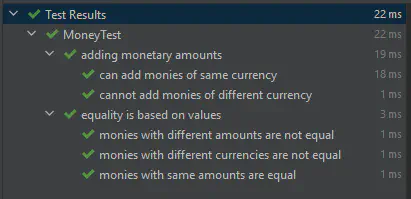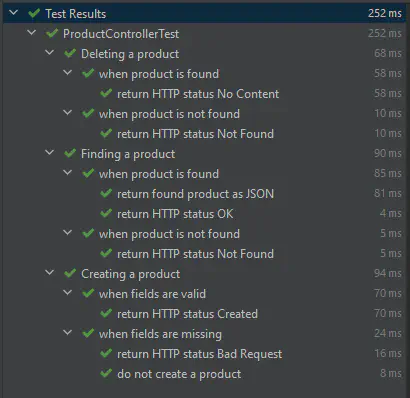本文翻译自JUnit 5 Nested Tests: Grouping Related Tests Together。

在本教程中我们讲学习如何利用JUnit 5编写嵌套测试,学习如何提供一个层级结构用于描述测试方法间的依赖关系。
本文是JUnit 5 教程的一部分。
如果你喜欢通过视频学习,可以查看Youtube中相关的学习视频
无嵌套测试
为了给嵌套测试奠定基础,首先看一个没有嵌套的例子,为了简洁起见省略了测试内容,完整的内容在GitHub中。
1
2
3
4
5
6
7
8
9
10
11
12
13
14
15
16
17
18
19
20
21
22
23
24
25
26
27
|
public class MoneyTest {
@Test
@DisplayName("monies with same amounts and currency are equal")
void moniesWithSameAmountsAndCurrencyAreEqual() {
CurrencyUnit eur = CurrencyUnit.of("EUR");
Money first = Money.of(eur, 3.99);
Money second = Money.of(eur, 3.99);
assertEquals(second, first);
}
@Test
@DisplayName("monies with different amounts are not equal")
void moniesWithDifferentAmountsAreNotEqual() { }
@Test
@DisplayName("monies with different currencies are not equal")
void moniesWithDifferentCurrenciesAreNotEqual() { }
@Test
@DisplayName("can add monies of same currency")
void addMoneyWithSameCurrency() { }
@Test
@DisplayName("cannot add monies of different currency")
void addMoneyWithDifferentCurrency() { }
}
|
此处我们有一个包含多个用于测试Money类的测试方法,Money中包含货币与金额,可检测Money实例是否相等,也可以对其相加。
当在命令行运行上述代码时,下面展示了大致的输出结果:
1
2
3
4
5
|
MoneyTest > monies with same amounts and currency are equal PASSED
MoneyTest > can add monies of same currency PASSED
MoneyTest > cannot add monies of different currency PASSED
MoneyTest > monies with different amounts are not equal PASSED
MoneyTest > monies with different currencies are not equal PASSED
|
此处没有太多的测试方法,所以仍然具有较好的可读性,然而,我们已经能够看出关联的测试方法在输出结果中没有分组在一起。
添加嵌套类
JUnit 5中的嵌套测试为我们提供了一种构建层级结构的实现,可基于逻辑结构组织测试,组织起来的嵌套结构能让我们更好的表述测试方法间的关系。
通过在测试类中创建内部类并添加@Nested注解,我们可在JUnit 5中创建嵌套测试,同样可通过添加@DisplayName注解给嵌套类赋予一个更容易阅读的名称。
1
2
3
4
5
6
7
8
9
10
11
12
13
14
15
16
17
18
19
20
21
22
23
24
25
26
27
28
29
|
public class MoneyTest {
@Nested
@DisplayName("equality is based on values")
class Equality {
@Test
@DisplayName("monies with same amounts are equal")
void moniesWithSameAmountsAreEqual() { }
@Test
@DisplayName("monies with different amounts are not equal")
void moniesWithDifferentAmountsAreNotEqual() { }
@Test
@DisplayName("monies with different currencies are not equal")
void moniesWithDifferentCurrenciesAreNotEqual() { }
}
@Nested
@DisplayName("adding monetary amounts")
class Addition {
@Test
@DisplayName("can add monies of same currency")
void addMoneyWithSameCurrency() { }
@Test
@DisplayName("cannot add monies of different currency")
void addMoneyWithDifferentCurrency() { }
}
}
|
这个例子没有特别之处,但我们已经将检查金额相等和金额累加的测试关注点分离开来了,该测试代码有更多层级结构,同时相关联的测试方法被更好的分组在一起。
在命令行中重置执行后,可以看见与之前的一些差异:
1
2
3
4
5
|
MoneyTest > adding monetary amounts > can add monies of same currency PASSED
MoneyTest > adding monetary amounts > cannot add monies of different currency PASSED
MoneyTest > equality is based on values > monies with different amounts are not equal PASSED
MoneyTest > equality is based on values > monies with different currencies are not equal PASSED
MoneyTest > equality is based on values > monies with same amounts are equal PASSED
|
与没有嵌套的测试相比,由于相关的测试被分组在一起,所以组织的更好一些,同代码类似,输出结果有更多的结构。
从IDE工具中运行后能看见添加嵌套结构后带来的额外好处,下图展示了在Intellij IDEA中运行后的结果:

在Intellij IDEA中运行嵌套测试
该报告看起来已经要好一些,每个嵌套类都可被展开或折叠,可只关注于想要的结果。
添加二级嵌套
来看一个更复杂的示例,我们正在测试一个REST controller,我们正在测试用于创建、读取和删除产品的HTTP POST、GET和DELETE方法,我们会检查验证各种内容,如请求正文字段和HTTP响应状态码。
1
2
3
4
5
6
7
8
9
10
11
12
13
14
15
16
17
18
19
20
21
22
23
24
25
26
27
28
29
30
31
32
33
34
35
36
37
38
39
40
|
class ProductControllerTest {
@Test
@DisplayName("POST returns HTTP status Bad Request when fields are missing")
void postReturnsHttpStatusBadRequestWhenFieldsAreMissing() throws Exception {
Product product = new Product(null, null, null);
mockMvc.perform(post("/product")
.contentType(MediaType.APPLICATION_JSON)
.content(objectMapper.writeValueAsString(product)))
.andExpect(status().isBadRequest());
}
@Test
@DisplayName("POST does not create a product when fields are missing")
void postDoesNotCreateProductWhenFieldsAreMissing() throws Exception { }
@Test
@DisplayName("POST returns HTTP status Created when fields are valid")
void postReturnsHttpStatusCreatedWhenFieldsAreValid() throws Exception { }
@Test
@DisplayName("GET returns HTTP status Not Found when product is not found")
void getReturnsHttpStatusNotFoundWhenProductIsNotFound() throws Exception { }
@Test
@DisplayName("GET returns HTTP status OK when product is found")
void getReturnsHttpStatusOkWhenProductIsFound() throws Exception { }
@Test
@DisplayName("GET returns found product as JSON when product is found")
void getReturnsFoundProductAsJsonWhenProductIsFound() throws Exception { }
@Test
@DisplayName("DELETE returns HTTP status Not Found when product is not found")
void deleteReturnsHttpStatusNotFoundWhenProductIsNotFound() throws Exception { }
@Test
@DisplayName("DELETE returns HTTP status No Content when product is found")
void deleteReturnsHttpStatusNoContentWhenProductIsFound() throws Exception { }
}
|
这些测试方法都有自定义名称,但描述信息和方法名称变的很长,我们甚至可以说已经变的很冗长。
在命令行中执行后会出现同样的问题:
1
2
3
4
5
6
7
8
|
ProductControllerTest > POST returns HTTP status Created when fields are valid PASSED
ProductControllerTest > DELETE returns HTTP status No Content when product is found PASSED
ProductControllerTest > GET returns HTTP status OK when product is found PASSED
ProductControllerTest > POST does not create a product when fields are missing PASSED
ProductControllerTest > GET returns HTTP status Not Found when product is not found PASSED
ProductControllerTest > DELETE returns HTTP status Not Found when product is not found PASSED
ProductControllerTest > GET returns found product as JSON when product is found PASSED
ProductControllerTest > POST returns HTTP status Bad Request when fields are missing PASSED
|
我们可看出,随着测试数量增加,输出内容开始变得有点难以阅读,虽然语言本身很容易阅读,但输出结果变得冗长,同时难以阅读。
现在我们可以看下如果在HTTP方法中添加嵌套、并为假设的场景添加另外一层嵌套(如产品存在/不存在)时会发生什么。
1
2
3
4
5
6
7
8
9
10
11
12
13
14
15
16
17
18
19
20
21
22
23
24
25
26
27
28
29
30
31
32
33
34
35
36
37
38
39
40
41
42
43
44
45
46
47
48
49
50
51
52
53
54
55
56
57
58
59
60
61
62
63
64
65
66
67
68
69
|
class ProductControllerTest {
@Nested
@DisplayName("Creating a product")
class Post {
@Nested
@DisplayName("when fields are missing")
class WhenFieldsAreMissing {
@Test
@DisplayName("return HTTP status Bad Request")
void returnHttpStatusBadRequest() throws Exception { }
@Test
@DisplayName("do not create a product")
void doNotCreateProduct() throws Exception { }
}
@Nested
@DisplayName("when fields are valid")
class WhenFieldsAreValid {
@Test
@DisplayName("return HTTP status Created")
void returnHttpStatusCreated() throws Exception { }
}
}
@Nested
@DisplayName("Finding a product")
class GetById {
@Nested
@DisplayName("when product is not found")
class WhenProductIsNotFound {
@Test
@DisplayName("return HTTP status Not Found")
void returnHttpStatusNotFound() throws Exception { }
}
@Nested
@DisplayName("when product is found")
class WhenProductIsFound {
@Test
@DisplayName("return HTTP status OK")
void returnHttpStatusOk() throws Exception { }
@Test
@DisplayName("return found product as JSON")
void returnFoundProductAsJson() throws Exception { }
}
}
@Nested
@DisplayName("Deleting a product")
class Delete {
@Nested
@DisplayName("when product is not found")
class WhenProductIsNotFound {
@Test
@DisplayName("return HTTP status Not Found")
void returnHttpStatusNotFound() throws Exception { }
}
@Nested
@DisplayName("when product is found")
class WhenProductIsFound {
@Test
@DisplayName("return HTTP status No Content")
void returnHttpStatusNoContent() throws Exception { }
}
}
}
|
测试代码看起来更长,但我们也能发现描述信息和方法名称变的更简洁。
现代IDE允许折叠和展开代码块,因此我们可以展开Post类和Delete类,可以只查看GeetById类。
通过IDE执行测试能够展示出测试结果有多少层级,下图为Intellij IDEA中的运行结果:

在Intellij IDEA中运行嵌套测试
在命令行中执行后,可发现输出结构中有更多的结构:
1
2
3
4
5
6
7
8
|
ProductControllerTest > Deleting a product > when product is found > return HTTP status No Content PASSED
ProductControllerTest > Deleting a product > when product is not found > return HTTP status Not Found PASSED
ProductControllerTest > Finding a product > when product is found > return found product as JSON PASSED
ProductControllerTest > Finding a product > when product is found > return HTTP status OK PASSED
ProductControllerTest > Finding a product > when product is not found > return HTTP status Not Found PASSED
ProductControllerTest > Creating a product > when fields are valid > return HTTP status Created PASSED
ProductControllerTest > Creating a product > when fields are missing > return HTTP status Bad Request PASSED
ProductControllerTest > Creating a product > when fields are missing > do not create a product PASSED
|
输出结果受益于嵌套,相关联的结果更容易被找到,如果我们设法创建一个经过深思熟虑的结构,它就像导航结果的面包屑一样便于使用。
避免陷阱
如果使用得当,JUnit 5嵌套测试可以成为一个强有力的工具,但是同其它的工具一样,使用嵌套测试也会伴随着一些陷阱。
忽略代码异味
当我们有编写嵌套测试的冲动时,我们应该问下自己为什么要这样做,如果测试类变得越来越大并且需要进行组织,或许意味着测试类正在做太多的事情。
我们应该问自己这些问题:
- 是否能够将任一嵌套类从测试类中抽取出来让它们只关注自身逻辑?
- 嵌套类中的任一假定测试是否意味着其在做不止一件事情?
相对于添加更多的结构来测试,我们应该考虑是否有必要进行重构,添加层级结构也会增加测试的复杂性,应该尽可能的避免添加复杂性。
试图消除重复
许多教程建议我们通过在@BeforeEach方法中构造共享对象并将它们定义为类成员变量来消除重复,这个建议的初衷是好的,但在测试代码中消除重复有更多的讲究。
我们仔细看下之前的产品controller测试:
1
2
3
4
5
6
7
8
9
10
11
12
13
14
15
16
17
18
19
20
21
22
23
24
25
|
@Nested
@DisplayName("when product is found")
class WhenProductIsFound {
@Test
@DisplayName("return HTTP status OK")
void returnHttpStatusOk() throws Exception {
Product product = new Product(1L, "Toothbrush", BigDecimal.valueOf(5.0));
when(productRepository.findById(1L)).thenReturn(product);
mockMvc.perform(get("/product/{productId}", 1L))
.andExpect(status().isOk());
}
@Test
@DisplayName("return found product as JSON")
void returnFoundProductAsJson() throws Exception {
Product product = new Product(1L, "Toothbrush", BigDecimal.valueOf(5.0));
when(productRepository.findById(1L)).thenReturn(product);
mockMvc.perform(get("/product/{productId}", 1L))
.andExpect(jsonPath("$.id", is(1)))
.andExpect(jsonPath("$.name", is("Toothbrush")))
.andExpect(jsonPath("$.price", is(5.0)));
}
}
|
由于在项目构造时存在重复代码,许多教程建议通过使用带有@BeforeEach注解的方法来消除重复:
1
2
3
4
5
6
7
8
9
10
11
12
13
14
15
16
17
18
19
20
21
22
23
24
25
|
@Nested
@DisplayName("when product is found")
class WhenProductIsFound {
@BeforeEach
void productFound() {
Product product = new Product(1L, "Toothbrush", BigDecimal.valueOf(5.0));
when(productRepository.findById(1L)).thenReturn(product);
}
@Test
@DisplayName("return HTTP status OK")
void returnHttpStatusOk() throws Exception {
mockMvc.perform(get("/product/{productId}", 1L))
.andExpect(status().isOk());
}
@Test
@DisplayName("return found product as JSON")
void returnFoundProductAsJson() throws Exception {
mockMvc.perform(get("/product/{productId}", 1L))
.andExpect(jsonPath("$.id", is(1)))
.andExpect(jsonPath("$.name", is("Toothbrush")))
.andExpect(jsonPath("$.price", is(5.0)));
}
}
|
不幸的是,该测试现在不是独立的,我们无法一眼看出与测试相关的所有内容,有更好的方法来消除重复,如辅助方法、测试数据构造器或对象母体。
进一步的检查示例代码,会发现第一个测试不关心属性值,而在第二个测试中字段值是关联信息。
现在可以看下使用构造器模式和辅助方法改写后的测试代码:
1
2
3
4
5
6
7
8
9
10
11
12
13
14
15
16
17
18
19
20
21
22
23
|
@Nested
@DisplayName("when product is found")
class WhenProductIsFound {
@Test
@DisplayName("return HTTP status OK")
void returnHttpStatusOk() throws Exception {
havingPersisted(aProduct().withId(1L));
mockMvc.perform(get("/product/{productId}", 1L))
.andExpect(status().isOk());
}
@Test
@DisplayName("return found product as JSON")
void returnFoundProductAsJson() throws Exception {
havingPersisted(aProduct().withId(1L).withName("Toothbrush").withPrice(5.0));
mockMvc.perform(get("/product/{productId}", 1L))
.andExpect(jsonPath("$.id", is(1)))
.andExpect(jsonPath("$.name", is("Toothbrush")))
.andExpect(jsonPath("$.price", is(5.0)));
}
}
|
我们可以立即看到每个测试只有相关信息,同时还可以一眼看出测试方法的作用。
可读性和消除重复是一个宽泛的话题,我们不准备在此处详细讨论,对于可读性和可维护性的深入分析会放到其它文章中。
总结
我们可通过嵌套测试来添加层级结构,可通过创建具有@Nested注解的内部类来创建嵌套测试。
嵌套测试有助于我们更好的描述测试方法之间的关系,嵌套测试还能够提高测试代码和测试结果的可读性和导航性。
本文的示例代码能在GitHub中找到。




